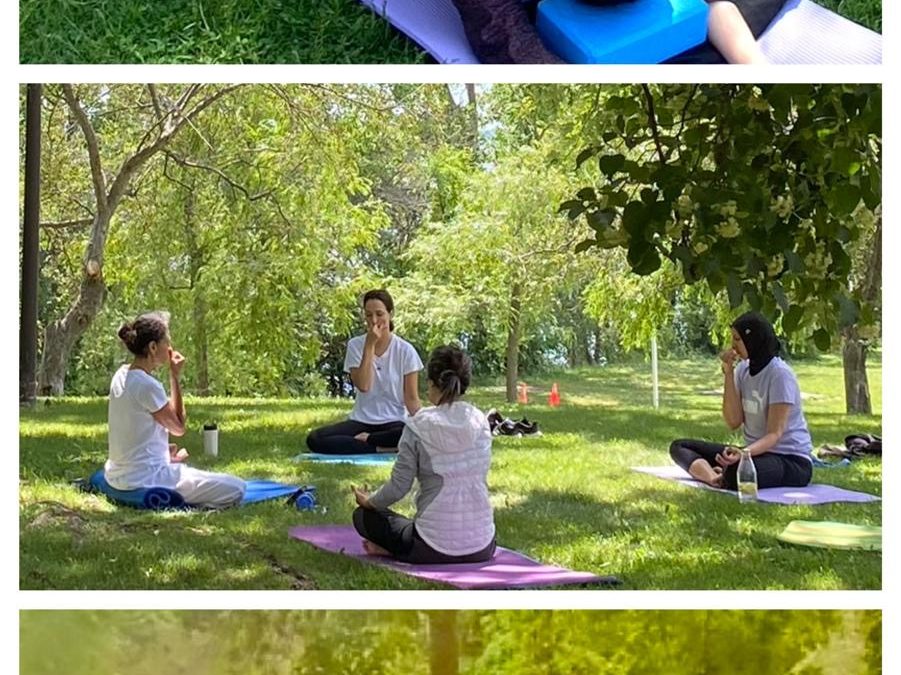Both yoga and yoga therapy offer beautiful gifts—they simply serve different needs. A dynamic vinyasa class can leave you energized and empowered, while a restorative session might melt away stress and tension. Group yoga therapy, while sharing yoga’s essence, has a distinct purpose: to guide you toward healing, self-awareness, and lasting mind-body connection.
In our modern lives, it’s easy to become disconnected from our bodies—we override fatigue, ignore discomfort, and lose touch with our natural rhythms. Yoga therapy creates a space to slow down, listen deeply, and rebuild trust in your body’s innate wisdom. It’s not about perfect poses, but about returning home to yourself—with compassion, curiosity, and a renewed sense of wholeness.
Here’s what makes group yoga therapy a uniquely transformative experience:
1. Gentle Practice with an Emphasis on Presence & Self-Acceptance
In yoga therapy, there’s no competition—not with others, and not with the version of yourself from the past. The practice is about listening to your body, honoring its needs, and moving in ways that nourish rather than deplete.
2. Honoring Your Body’s Unique Needs
In a typical yoga class, the pace may follow a set flow or sequence designed for the whole group. In group yoga therapy, you’re guided to listen to your body and choose the level of intensity that feels right for you. There’s no competition—not with others, and not even with your past self. Instead, you explore ways of moving that feel nourishing, sustainable, and supportive rather than depleting.
3. Clear Therapeutic Focus
Each session is designed with a therapeutic intention—such as easing back discomfort, supporting healthy joints, improving breathing capacity, reducing stress, or enhancing balance. The focus is on progressive improvement over time, meeting you where you are and guiding you toward more ease and function.
4. Cultivating Prana (Life Force Energy)
A key element of yoga therapy is working with prana—the subtle energy that sustains vitality. Through intentional breathwork (pranayama), mindful movement, and stillness, practices are sequenced to encourage the free flow of this life force, supporting the body’s natural capacity to restore balance and vitality.
5. Ripple Effects into Daily Life
The benefits of yoga therapy extend far beyond the mat. As you cultivate greater body awareness, the principles you practice naturally weave into daily life. Simple yet powerful tools—posture adjustments, mindful breathing in moments of stress, gentle stretches at your desk—begin to feel effortless.
What starts as intentional practice gradually becomes a way of living. These shifts aren’t dramatic, but their quiet consistency creates lasting change. As your connection with your body deepens, you find yourself making choices that truly nourish your wellbeing—not out of obligation, but from genuinely listening to what your whole self needs.
6. Healing the Mind–Body Disconnect
Modern life trains us to push through fatigue, ignore discomfort, and tune out what we truly feel. Yoga therapy helps reverse this pattern by restoring trust in the body’s wisdom.
As Donna Farhi writes in YogaU Online:
“To live in a body that is fully connected to its capacity for feeling means cultivating the courage to remain open—even when openness feels challenging… meeting discomfort with curiosity rather than fear.”
Through mindful movement and breath, yoga therapy teaches us to stay present with sensation, meet discomfort with curiosity, and build resilience from the inside out. Over time, this practice shifts how we inhabit our bodies and respond to life—turning discomfort into guidance toward greater wholeness.
7. Tools for Emotional Resilience & Growth
Through relaxation, somatic awareness, meditation, and self-inquiry, you’ll learn to manage stress and emotions with greater ease. These practices build inner stability, resilience, and clarity, helping you navigate life’s challenges with steadiness and confidence.
8. Small-Group Connection & Shared Healing
While regular yoga classes can be a beautiful community experience, group yoga therapy tends to be smaller and more intimate. There’s often time for check-ins, shared reflections, and a sense of mutual encouragement—without pressure to share more than you wish.
9. A Pace that Honors Recovery & Integration
Sessions are intentionally paced to allow for pauses, rest, and integration. This can be especially helpful for those working with chronic conditions, recovering from illness or injury, or simply needing a slower rhythm to reconnect with their body’s signals.
The Takeaway
Both regular yoga and group yoga therapy are valuable; they simply serve different needs. Group yoga therapy offers a structured, compassionate space to explore movement, breath, and awareness with therapeutic goals in mind. It meets you where you are, honors your body’s story, and supports you in moving toward greater ease, clarity, and vitality.
Group Yoga Therapy vs. Regular Yoga Classes – Different Focus, Shared Benefits
Both group yoga therapy and regular yoga classes nurture the mind, body, and spirit—they just take different routes to get there. One offers a therapeutic, highly personalized approach, while the other often provides a broader, dynamic experience. Many people find that blending the two gives them the best of both worlds.
| Aspect | Regular Yoga Classes | Group Yoga Therapy |
|---|---|---|
| Purpose & Focus | Often aims for general fitness, flexibility, strength, or stress relief; can be dynamic (e.g., vinyasa) or restorative. | Focused on healing, self-awareness, and mind-body connection; guided toward therapeutic outcomes. |
| Pace & Structure | Follows a set flow or sequence for the whole group; pace may vary by class style. | Intentionally paced to allow rest, integration, and recovery; individualized adjustments encouraged. |
| Body Awareness & Self-Acceptance | Less emphasis on internal signals; more about following the instructor and sequence. | No competition—participants listen to their own bodies, honoring needs and moving in nourishing ways. |
| Therapeutic Intention | General wellbeing; may not address specific physical or emotional needs. | Each session has a therapeutic goal (e.g., easing discomfort, improving breathing, supporting joints). |
| Prana (Life Force Energy) | Breath often integrated into movement; less focus on energy flow or sequencing. | Mindful movement, stillness, and pranayama sequenced to support the free flow of prana and restore balance. |
| Mind-Body Connection | Benefits can include relaxation, stress relief, and increased body awareness. | Actively restores trust in the body, helps process discomfort, and cultivates resilience through mindful awareness. |
| Daily Life Integration | Benefits may carry over naturally but aren’t explicitly reinforced. | Practices encourage awareness and tools (posture, breathing, stretches) that extend into everyday life. |
| Emotional Resilience & Growth | General stress reduction; emotional work is secondary. | Provides tools for managing stress, anxiety, and overwhelm; builds clarity, steadiness, and resilience. |
| Group Dynamics & Community | Typically larger classes; community is present but less intimate. | Smaller, more intimate groups with time for check-ins, shared reflections, and supportive connections. |
| Recovery & Healing Support | Pace may not accommodate chronic conditions, injury, or slower recovery. | Sessions honor recovery and integration; suitable for chronic conditions, injury, or gentle rehabilitation. |
| Outcome | Energy, empowerment, flexibility, relaxation. | Healing, self-awareness, improved mind-body connection, resilience, and sustainable wellbeing. |
“What has your experience with yoga therapy been like? Whether you’re just beginning or have been practicing for years, share your insights with our community below.



Very interesting
I can relate …
Yoga therapy changed my whole perspective on yoga and gave me new horizons .